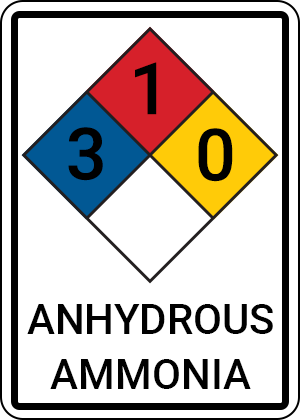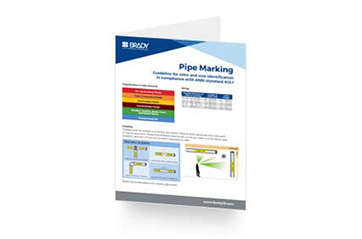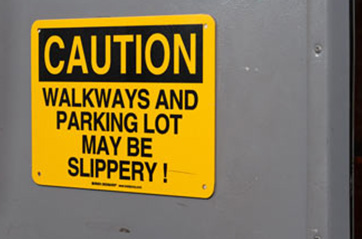Labels for Safety, Visuals and Facility ID Desktop Printers
Labels for Product, Wire and Lab ID Benchtop Printers
Labels for Safety, Visuals and Facility ID Desktop Printers
Labels for Product, Wire and Lab ID Benchtop Printers
Safety and Facility ID Desktop Printers
Product, Wire and Lab ID Benchtop Printers
Barcode Scanners and RFID Readers
PaintStripe Floor Marking Stencils
Valve Lockouts & Hose Lockouts
Group Lock Boxes & Permit Control
Brady Safety Lockout Tagout Services
Pipe Marker Accessories & Mounting Brackets
Maintenance and Production Tags
Calculators and Assessment Tools
Product Finders and Data Sheets
Pressurized anhydrous ammonia is used as a commercial refrigerant due to its ability to absorb substantial amounts of heat from its surroundings. Industrial settings that use it, including food and beverage processing, cold storage and meatpacking, must adhere to ammonia pipe labeling requirements. Below, we'll break down the standards and requirements, including the ammonia piping color code, lettering and placement set forth by ANSI/ASME, in addition to the International Institute of Ammonia Refrigeration's IIAR Bulletin 114. Before you dig in to the standards, however, it’s important to understand the dangers of ammonia and the importance of using pipe labels and tags on this potentially hazardous chemical.
Uncontrolled releases of anhydrous ammonia can be harmful to human health, corrosive and explosive when not properly maintained or controlled. Anhydrous ammonia carries a health hazard designation of 3 on the NFPA fire diamond, with threats including:
The EPA has documented a number of accidents, including a meat-packing plant where a refrigeration line ruptured. Eight workers were critically injured, suffering respiratory burns from ammonia inhalation.[1]

When workers and emergency response personnel follow ammonia pipe labeling standards, it helps effectively identify the pipe and follow where it’s going, especially to valve shutoffs in order to stem further release. Pipes that adhere to IIAR pipe marking standards can also be used in safety training for current and new employees and assist with efficiency during maintenance and servicing. During such events using proper lockout tagout devices, like valve lockouts, in conjunction with proper labels can ensure the safety of you and your team.
Two organizations supply documents that inform how ammonia pipes are to be labeled:
This ASME standard is a widely used guideline in determining pipe identification requirements. It indicates that “A13.1 is intended to establish a common system to assist in identification of hazardous materials conveyed in piping systems and their hazards when released in the environment.” Find additional information on ANSI pipe marking standard guidelines.
| Label Color | Text Color | Pipe Contents |
| Red | White | Fire-quenching fluids |
| Orange | Black | Toxic and corrosive fluids |
| Yellow | Black | Flammable fluids |
| Brown | White | Combustible fluids |
| Green | White | Potable, cooling, boiler feed and other water |
| Blue | White | Compressed air |
| Purple | White | Defined by user |
| Gray | ||
| Black | ||
| White | Black | Defined by user |
IIAR Bulletin 114 is meant to “establish uniform guidelines for identifying piping in a closed-circuit ammonia refrigeration system and the related refrigeration system components.” IIAR Bulletin 114 offers these guidelines specifically for the ammonia refrigeration industry, and uses ASME Standard A13.1 to inform it. As anhydrous ammonia is classified as a “toxic and corrosive fluid,” safety orange is the appropriate base label color.
Important note: IIAR Bulletin 114 was updated in 2014 to accurately reflect safety orange as the primary recommended label color under an update to the ASME standard in 2007. Prior to that, yellow was used. However, this doesn’t mean that all markers, including those made prior to 2014, must be updated. Section 1 of ASME A13.1 states that “Existing schemes for identification shall be considered as meeting the requirements of this Standard if: (a) such schemes are described in writing; (b) employees are trained as to the operation and hazards of the piping system.”

There are 5 sections on an ammonia pipe label that follow the ammonia piping color code and other requirements.
Marker body (ammonia)
The pipe marker body should be safety orange with “AMMONIA” printed in black letters.
Physical state (liquid, vapor or both)
Ammonia refrigerant exists in a liquid or vapor state, or both. Following are guidelines for each:
Pressure (high or low)
Abbreviations (HTRL, LTRS, etc.)
Industrial ammonia refrigeration systems are composed of interconnected pipes with varying temperature, vents, suctions, discharges and more. Abbreviated names identify these specific parts of the system. Abbreviations should be printed in black letters on the safety orange field adjacent and left of the physical state.
Directional arrow ( ← → )
Directional arrows should be black in color and proportionate in size to the marker. They may or may not be applied around the full pipe circumference.
List of common abbreviations (see sec. 4)
| Abbr. | System |
| BD | Booster Discharge |
| CD | Condenser |
| DC | Defrost Condensate |
| EQ* | Equalizer |
| ES | Economizer Suction |
| HGD | Hot Gas Defrost |
| HPL | High Pressure Liquid |
| HSD | High Stage Discharge |
| HSS | High Stage Suction |
| HTS* | High Temperature Suction |
| HTRL | High Temperature Recirculated Liquid |
| HTRS | High Temperature Recirculated Suction |
| LTRL | Low Temperature Recirculated Liquid |
| LTS* | Low Temperature Suction |
| LTRS | Low Temperature Recirculated Suction |
| LIC | Liquid Injection Cooling |
| LSS | Low Stage Suction |
| PO* | Pump Out |
| PU* | Purge |
| RV | Relief Vent |
| TSR | Thermosyphon Return |
| TSS | Thermosyphon Supply |
*Not currently covered in the IIAR standard
Put the power of on-demand printing in your facility’s toolbox. Or, select from a variety of preprinted ammonia pipe markers.
Control messaging and inventory with these modular kits. Simply add specific text and arrow legends to the pipe marker body using Brady Workstation premade templates. Then print using a compatible Brady printer and apply physical state and pressure labels.
Convenience and customization come together perfectly thanks to this this all-in-one inkjet printing solution. Using Brady Workstation software and premade templates, you can easily create full-color labels, hit print once and apply where you need.
Select from markers with prepopulated text. Then choose different sizes and materials that ensure your markers fit where you need and hold up in the environments they face.
References

Understand this history, elements and implementation of the NFPA 704 Hazard Diamond.
Learn More
What are OSHA's requirements related to ANSI Pipe Marking Standards?
Learn More
Understand the types, requirements and use for workplace safety signs and symbols.
Learn More